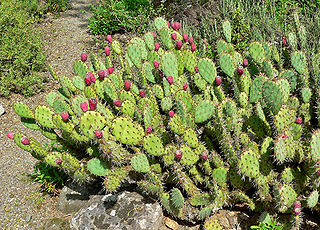
Cactoblastis cactorum, the cactus moth, South American cactus moth or nopal moth, is native to Argentina, Paraguay, Uruguay and southern Brazil. It is one of five species in the genus Cactoblastis that inhabit South America, where many parasitoids and pathogens control the expansion of the moths' population. This species has been introduced into many areas outside its natural range, including Australia, the Caribbean, and South Africa. In some locations, it has spread uncontrollably and was consequently classified an invasive species. However, in other places such as Australia, it has gained favor for its role in the biological control of cacti from the genus Opuntia, such as prickly pear.
Laniifera is a genus of snout moths in the subfamily Spilomelinae of the family Crambidae. The genus was erected by George Hampson in 1899 with Pachynoa cycladesDruce, 1895 as type species.

Opuntia, commonly called prickly pear or pear cactus, is a genus of flowering plants in the cactus family Cactaceae. Prickly pears are also known as tuna (fruit), sabra, nopal from the Nahuatl word nōpalli for the pads, or nostle, from the Nahuatl word nōchtli for the fruit; or paddle cactus. The genus is named for the Ancient Greek city of Opus, where, according to Theophrastus, an edible plant grew and could be propagated by rooting its leaves. The most common culinary species is the Indian fig opuntia (O. ficus-indica).

Melitara dentata, the North American cactus moth, is a moth of the family Pyralidae. The species was first described by Augustus Radcliffe Grote in 1876. It is native to western North America, where it is widespread from Alberta to southern Arizona and central Texas. It is an introduced species in Hawaii.
Melitara prodenialis is a moth of the family Pyralidae described by Francis Walker in 1863. It is native to North America, where it is known from south-eastern New York to Florida along the Atlantic coastal plain, and west to eastern Oklahoma and north-central and south-eastern Texas. It is an introduced species in Hawaii. It is a special concern species in Connecticut.
Melitara doddalis is a species of snout moth in the genus Melitara. It was described by Harrison Gray Dyar Jr. in 1925, and is found in the United States in southern Arizona, southern New Mexico, south-western Texas and in northern Mexico.
Melitara junctolineella is a species of snout moth in the genus Melitara. It was described by George Duryea Hulst in 1900. It is found in southern Texas and Mexico. The species has been introduced in Australia as a biological control agent of Opuntia stricta.
Melitara subumbrella is a species of snout moth in the genus Melitara. It was described by Harrison Gray Dyar Jr. in 1925. It is widespread in western North America, from southern Alberta and Saskatchewan to southern Arizona, central Texas, southern New Mexico and south-eastern California.
Ozamia fuscomaculella is a species of snout moth in the genus Ozamia. It was described by William S. Wright in 1916. It is found in the US state of California.
Ozamia clarefacta is a species of snout moth in the genus Ozamia. It was described by Harrison Gray Dyar Jr. in 1919. It is found in Texas and Mexico
Ozamia hemilutella is a species of snout moth in the genus Ozamia. It was described by Harrison Gray Dyar Jr. in 1922. It is found in Argentina.
Ozamia lucidalis is a species of snout moth in the genus Ozamia. It was described by Francis Walker in 1863. It is found on Hispaniola and Jamaica, as well as Cuba and in Mexico, on the Florida Keys and Texas.
Ozamia immorella is a species of snout moth in the genus Ozamia. It was described by Harrison Gray Dyar Jr. in 1913. It is found in Mexico.
Zophodia multistriatella is a species of snout moth in the genus Zophodia. It was described by André Blanchard and Edward C. Knudson in 1982. It is found in the US states of Texas, Arizona and New Mexico.
Tucumania porrecta is a species of snout moth in the genus Tucumania. It was described by Harrison Gray Dyar Jr. in 1925. It is found in Uruguay.
Tucumania tapiacola is a species of snout moth in the genus Tucumania. It was described by Harrison Gray Dyar Jr. in 1925. It is found in Argentina and has been introduced to Australia and South Africa.
Zophodia analamprella is a species of snout moth in the genus Zophodia. It was described by Harrison Gray Dyar Jr. in 1922. It is found in Argentina and is possibly also present in Paraguay.
Zophodia huanucensis is a species of snout moth in the genus Zophodia. It was described by Carl Heinrich in 1939. It is found in Peru.
Zophodia nephelepasa is a species of snout moth in the genus Zophodia. It was described by Harrison Gray Dyar Jr. in 1919. It is found in Mexico.
Laniifera cyclades is a snout moth in the subfamily Spilomelinae of the family Crambidae. It was described by Herbert Druce in 1895, based on three imagines collected in Mexico City and near Durango City in Mexico. Apart from Mexico, the species is also found in the states of Arizona and Texas in the United States.


